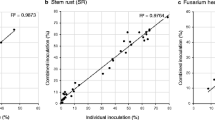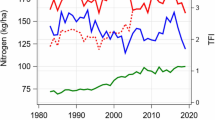Abstract
White mold, caused by the fungus Sclerotinia sclerotiorum (Lib.) de Bary is currently one of the major diseases affecting bean cultivars, especially in irrigated crops, and extremely difficult to control. Genetic improvement in the form of more resistant lines has been sought for inclusion in the integrated management of this disease. When selecting resistant genotypes, an efficient, fast and simple evaluation method regarding plant reactions to the pathogen is required. In this context, the aim of the present study was to compare straw and seedling phenotyping methods in the evaluation of disease progression by nonlinear models and evaluate the interaction of the phenotyping method with genotype resistance and evaluation timeframes. The results indicate that both phenotyping methods are well correlated regarding bean resistance groups. The applied methods lead to distinct inferences on genotype resistance, and disease progress is closely linked to the resistance level of the evaluated genotype. Both phenotyping methods are efficient, but in different situations. The symptom progression models display similar adjustments to the symptom levels of both methods.



Similar content being viewed by others
References
Aho K, Derryberry D, Peterson T (2014) Model selection for ecologists : the worldviews of AIC and BIC. Ecology 95:631–636
Antonio RP (2011) Identificação de QTLs de resistência ao mofo branco e de mecanismos bioquímicos envolvidos na resposta de defesa em feijoeiro. Universidade Federal de Lavras
Arkwazee H, Myers JR (2017) Seedling straw test: a rapid and resource-efficient method for evaluating white mold resistance. Annual Report of the Bean Improvement Cooperative 60:39–40
Arkwazee H, Davis J, Myers J (2017) Comparison of the conventional and seedling straw tests for quantifying white mold resistance. Annual Report of the Bean Improvement Cooperative 60:41–42
Baty F, Ritz C, Charles S et al (2015) A toolbox for nonlinear regression in R: the package nlstools. J Stat Softw 66:1–21
Bergamin Filho A (2011) Curvas de progresso da doença. In: Manual de fitopatologia: princípios e conceitos, 3rd edn. Editora Ceres, São Paulo, pp 647–666
Beruski GC (2013) Incidência e severidade de mofo branco em soja cultivada sob diferentes densidades populacionais e espaçamentos. Universidade Estadual de Ponta Grossa
Bolton MD, Thomma BPHJ, Nelson BD (2006) Sclerotinia sclerotiorum (lib.) de Bary: biology and molecular traits of a cosmopolitan pathogen. Mol Plant Pathol 7:1–16
Campbell CL, Madden L V. (1990) Introduction to plant disease epidemiology. John Wiley & Sons., New York - USA
Cunniffe NJ, Koskella B, Metcalf CJ et al (2015) Thirteen challenges in modelling plant diseases. Epidemics 10:6–10. https://doi.org/10.1016/j.epidem.2014.06.002
Ferreira LU, Ribeiro VA, Melo PGS et al (2018) Comparison of inoculation methods for selecting common bean genotypes with physiological resistance to white mold. Tropical Plant Pathology. https://doi.org/10.1007/s40858-018-0258-5
Garcia RA, Juliatti FC (2012) Avaliação da resistência da soja a Sclerotinia sclerotiorum em diferentes estádios fenológicos e períodos de exposição ao inóculo. Tropical Plant Pathology 37:196–203
Griffiths PD, Sandsted E, Halseth D (2012) Release of Cornell 607-612: common bean breeding lines with resistance to white mold. HortScience 47:952–954
Harikrishnan R, Río LE del (2008) A logistic regression model for predicting risk of white Mold incidence on dry bean in North Dakota. Plant Dis 92:42–46
Heffer Link V, Johnson KB (2007) White Mold (Sclerotinia). In: The Plant Health Instructor. http://www.apsnet.org/edcenter/intropp/lessons/fungi/ascomycetes/Pages/WhiteMold.aspx. Accessed 18 Feb 2017
Jing L, Navi SS, Yang X (2015) Effects of colonisation by different strains of Coniothyrium minitans on the viability of sclerotia of Sclerotinia sclerotiorum. Biocontrol Sci Tech 25:460–474
Juliatti CF, Figueiró AA, Garcia RA et al (2015) Sclerotinia sclerotiorum e Mofo branco: Estudos básicos e aplicados. Revisao Anual de Patologia de Plantas 23:159–194
Lehner M et al (2015) Adaptation and resistance to diseases in Brazil of putative sources of common bean resistance to white Mold. Plant Dis 99:1098–1103
Leite ME, Dias JA, de SDA et al (2016) Increasing the resistance of common bean to white mold through recurrent selection. Sci Agric 73:71–78
Lopes FS (2017) Seleção recorrente em feijão visando resistência ao mofo branco em casa de vegetação. Universidade Federal de Lavras
Madden L V., Hughes G, van den Bosch F (2007) The study of plant disease epidemics., 1st edn. American Phytopathological Society (APS Press), Minnesota
Martin A, Bovill WD, Percy CD, Herde D, Fletcher S, Kelly A, Neate SM, Sutherland MW (2015) Markers for seedling and adult plant crown rot resistance in four partially resistant bread wheat sources. Theor Appl Genet 128:377–385
McKenna P, Cannon N, Conway J (2018) Soil mineral nitrogen availability predicted by herbage yield and disease resistance in red clover (Trifolium pratense) cropping. Nutr Cycl Agroecosyst 112:303–315
Melzer MS, Boland GJ (1994) Epidemiology of lettuce drop caused by sclerotinia minor. Can J Plant Pathol 16:170–176
Mila AL, Carriquiry AL, Yang XB (2004) Logistic regression modeling of prevalence of soybean Sclerotinia stem rot in the north-central region of the United States. Phytopathology 94:102–110
Rahman MME, Hossain DM, Suzuki K, Shiiya A, Suzuki K, Dey TK, Nonaka M, Harada N (2016) Suppressive effects of Bacillus spp. on mycelia, apothecia and sclerotia formation of Sclerotinia sclerotiorum and potential as biological control of white mold on mustard. Australas Plant Pathol 45:103–117
Schwartz HF, Singh SP (2013) Breeding common bean for resistance to white Mold: a review. Crop Sci 53:1832
Scott AJ, Knott M (1974) A cluster analysis method for grouping means in the analysis of variance. Biometrics 30:507
Silva M, Vale F, Zambolim L (1998) Caracterizaçao da curva de progresso da ferrugem do feijoeiro em diferentes épocas de plantio em viçosa. MG Fitopatologia Brasileira 23:139–142
Silva PH, Santos JB, Lima IA, Lara LAC, Alves FC (2014) Reaction of common bean lines and aggressiveness of Sclerotinia sclerotiorum isolates. Genet Mol Res 13:9138–9151. https://doi.org/10.4238/2014. November 7 11
Singh SP, Schwartz HF, Steadman JR (2014) A new scale for white mold disease rating for the common bean cut-stem method of inoculation in the greenhouse. Annual Report of the Bean Improvement Cooperative 57:231–232
Spósito MB, Bassanezi RB, Amorim L (2004) Resistência à Mancha Preta dos Citros Avaliada por Curvas de Progresso da Doença. Fitopatol Bras 29:537–537
Steffenson BJ, Hayes PM, Kleinhofs A (1996) Genetics of seedling and adult plant resistance to net blotch (Pyrenophora teres f. Teres) and spot blotch (Cochliobolus sativus) in barley. Theor Appl Genet 92:552–558
Viteri DM, Otto K, Terán H, Schwartz HF, Singh SP (2015) Use of four Sclerotinia sclerotiorum isolates of different aggressiveness, three inoculations per plant, and delayed multiple evaluations to select common beans with high levels of white mold resistance. Euphytica 204:457–472
Zegeye H, Rasheed A, Makdis F, Badebo A, Ogbonnaya FC (2014) Genome-wide association mapping for seedling and adult plant resistance to stripe rust in synthetic hexaploid wheat. PLoS One 9:e105593
Acknowledgments
The authors would like to thank Coordination of Improvement of Higher Education Personnel in Brazil (Capes) and the National Council for Scientific and Technological Development (CNPq) for the financial support in the development of this project.
Author information
Authors and Affiliations
Corresponding author
Rights and permissions
About this article
Cite this article
Porto, A.C.M., Gwinner, R., Miranda, R.N. et al. Choice of improved phenotyping methods for bean plant reactions to white mold by non-linear model adjustments of symptom progression. Australasian Plant Pathol. 48, 257–266 (2019). https://doi.org/10.1007/s13313-019-0625-9
Received:
Accepted:
Published:
Issue Date:
DOI: https://doi.org/10.1007/s13313-019-0625-9




